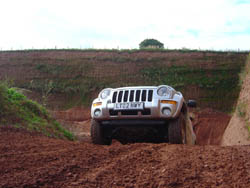|
|
 |
 |
 |
Concepts
High and Low Range
|
 |
|
Gearing lets your car move forward and backwards, and, by selecting
a higher gear, lets your axles (and consequently your vehicle) move
faster than engine rpms. In four wheel drive, however, gearing is also
used to help you over difficult terrain such as steep hills.
|
 |
| High Range |
|
High range gears are the gears normally found in any
motor vehicle. These gears are used for day-to-day
driving on tarmac, motor ways and in the city. High
range gearing uses a high gear ratio (3:1 in the figure
at right) to spin the axle with speed, but a lesser
amount of torque.
|
|
 |
|
 |
| Low Range |
|
With low range gearing, the opposite holds true - the
axle spins at a much lower rpm, but with a huge amount
of torque (1:3 in the firgure at right). The vehicle
therefore moves substantially slower, but with much
more power. When driving off-road this is beneficial
for a number of reasons. For example, when
driving up a steep
hill
a car equipped with high range, or "normal"
gears, would lack the power to make it to the top and,
in all likelyhood, stall. However, a vehicle equipped
with low range gears would simply drive on up because
of the added torque.
|
|
 |
|
 |
 |
|
Many of today's leisure four wheel drives (such as the
Land Rover Freelander and Toyota RAV4) do not come
equipped with low range gearing, and consequently are
not very capable performers in the really rough stuff.
To reach the top of the hill depicted in the picture
at left, a vehicle not equipped with low range would
require a huge amount of momentum. Excessive momentum
in turn can cause you to damage your vehicle and
possibly injure yourself. So think about how you intend
using your vehicle before making a purchasing decision.
|
|
 |
© 1998-2013 Martin Wittenburg and Michael Wittenburg. All rights reserved.
|